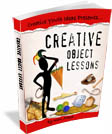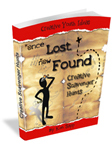Balloons are enjoyed not only by children and youth, but by people of all ages. We see them at birthdays and celebrations throughout the year. And like many things we enjoy in the world around us, they can be metaphors for spiritual lessons as well.
PLEASE SHARE THIS IDEA ON FACEBOOK – CLICK HERE
What You Need
- Lots of balloons
- The Object lesson at the end requires Additional Resources
Some of my favourite Balloon Games for Youth
- Air Race – Be the first to get a balloon to the other side of the room by blowing it up and letting it go. Where ever the balloon lands, the youth can pick it up and repeat the process.
- Balloon Bump – Divide youth into two teams and give each team a different colored balloon. The team must hit its balloon in the air and not allow it to touch the ground. If a team’s balloon touches the ground the other team gets a point. To add to the excitement, add more balloons. Vary the game by choosing the body part that they must use to bump the balloon – elbows, knees, head, etc.
- Balloon Capture the Flag – Give each team a color. Randomly hide balloons of the various team colors throughout the building. Teams start from a central BASE and must explore the building rescuing balloons of their own color by bringing them back to the BASE. All balloons inside the base are safe. Teams can also pop opposing team member’s balloons by sitting on them. At the end of a designated time period the team which rescued the most balloons of their team color wins.
- Balloon Caterpillar – Split the youth into teams of 3 to 6 and have them line up with their hands on the hips of the person in front of them. Attach a balloon to the backside of the last person in the line’s belt. If they don’t have a belt you can use a length of string around his or her waste. Teams must move around, keeping their hands on the waist of the person in front of them and try to pop the balloons at the end of the other teams. The only person that use his or her hands is the person at the fron of the caterpillar.
- Balloon Duels – Split the youth into two teams. Line up each team from shortest to tallest. Then Ask them to count off so that each youth on a team has a number. Tie an inflated balloon with an arms length of string to the ankle of each youth. To play, call out a number. The two players with that number come to the center of the room and try to stomp each other’s balloons. If you pop your opponent’s balloon first, your team gets a point. Repeat this process until all have played. The team with the greatest number of points wins.
- Balloon hacky sack – See how many taps or how long a team can keep a balloon in the air without it touching the ground.
- Balloon Identity – Everyone must write one piece of information about themselves on a small strip of paper and place it in a balloon. They then blow up the balloon and throw the balloon in the center of the circle of youth. One by one, participants select a balloon, pop it, and try to guess which youth matches the piece of information.
- Balloon Juggling – Inflate an equal number of balloons for each team and place them in a plastic trash bag. The team must keep all the balloons in the air. Start with one balloon and every few seconds add another balloon until one of them touches the floor. The team that is able to keep the most balloons in the air wins.
- Balloon Shaving – Divide into teams and give each team a fully inflated balloon to be held in one team member’s mouth. Cover it with whip cream or shaving cream and give each team a disposable razor. First team to remove the shaving cream wins.
- Balloon Smashdown – Each youth is given a balloon with her or her name on it and must keep it in the air by tapping it from below. But at the same time others can tap it from above and try to get it to touch the ground. Everyone begins standing up, but if a balloon touches the ground the own must then get on their knees. If it touches the floor again they must sit, then lie on the floor, then they are out.
- Balloon Stomp – Using an arm’s length of string or a rubber band, tie a balloon to the ankle of each youth so that it drags on the floor a few inches behind their feet. Then they must run around the room and try to pop each other’s balloons by stepping on them while also trying to prevent their own balloon from being popped. Last person to have their balloon unpopped wins. Best played with shoes removed. You can even make it more fun by adding a freeze portion. When the music stops, everyone must stop.
- Balloon to Chair Relay – In teams, each person on the team must inflate a balloon, tie ot off, then race to a chair at the opposite end of the room and pop it by sitting on it. This can be very funny as some balloons refuse to pop easily and the youth are hopping up and down on them to pop them. First team to complete the relay wins.
- Balloon Volleyball – Set up a divider across the room and play a game of volleyball with balloons.
- Hot Air Race – Have a competition to see who can be the first to blow up a balloon until it pops.
- Human Foosball – Seat the youth in rows, either on chairs or on the floor so that every other row turns around and faces the opposite direction. Use a balloon to bat around like a volleyball. A point is scored when a team taps the balloon past all of the opposing team and hits the wall (indoors) or beyond a boundary (outdoors). Highest number of points wins.
- Sumo Wrestling – Teams choose the smallest person to be a “Sumo Wrestler” who will put on an oversized sweatshirt and pants. Each team is given an equal number of balloons to blow up, tie them in a knot, and “stuff” them in the pants and shirt of the Sumo Wrestler. The first team to blow up all balloons and make a Sumo Wrestler wins. For a part 2, the first Sumo wrestler to pop all his or her balloons first wins.
- Twins – Youth are divided into pairs and placed back to back with a balloon in between them. The first pair to pop the balloon using only their backs wins.
- Two Man Balloon Run – A two man team must run through an obstacle course using only their stomachs or head to hold the balloon between them. Anyone holds the balloon in their hands or lets the balloon touch the ground must stop and go back to the start to begin again.
TAKE IT TO THE NEXT LEVEL
An Object Lesson using Balloons
What You Need
- Two balloons – Add a little water into one before you inflate it and tie it off. The other should just have air.
- A candle and something to light it with.
- NOTE: Practice this yourself first before trying it with the youth.
What to do
- Begin by lighting the candle.
- Explain that the balloon (the one without water in it) represents a person’s life.
- Explain that there are some things we face in life that are painful or even destructive.
- Hold the stem of the balloon and touch it to the flame and it will pop.
- Some people’s lives are destroyed by the difficulties they face.
MAKE IT SPIRITUAL
Read James 1:2-4
- What are some of the things youth experience in life that are painful?
- Ask the youth to share some of the trials a typical youth may face?
- What are some trials that Christians may face?
- Take out the balloon with a bit of water in it without drawing attention to the water inside.
- Move the balloon with water in it toward the flame.
- while holding the stem of the balloon, move it in a very small circle on top of the flame so that it is directly over the flame, but so that the flame is not concentrated on one spot for two long. You can do this for quite a long time – at least 10 seconds without the balloon popping. This is because the little bit of the water in the balloon draws the heat away from the balloon and disperses it.
- Explain that the balloon has a bit of water inside it and this allows it to withstand the fiery trial.
MAKE IT PRACTICAL
- In John 7:37-38 Jesus promises us that if we come to Him, he will give us living water.
- Romans 8:28 tells us that when Christ is in our lives, all things work for good.
- If we have Jesus, the living water, in our lives, we will be victorious over the circumstances of life and the fiery trials.
- What are some of the circumstances, trials, or difficult situations you face in which you can you let Christ take the heat for you?
- What difference does Christ make in a person’s life?
MAKE IT PERSONAL
- What difference has Christ made in your life?
- How can Christ help you to face the your own circumstances trials or difficult situations?
- What can you do differently this week to trust Christ in the situations you will face?
KEY SCRIPTURE VERSE
James 1:2-4
“Consider it pure joy, my brothers and sisters, whenever you face trials of many kinds, because you know that the testing of your faith produces perseverance. Let perseverance finish its work so that you may be mature and complete, not lacking anything.”
PLEASE SHARE THIS IDEA ON FACEBOOK – CLICK HERE
 MORE IDEAS? See “Creative Object Lessons”
MORE IDEAS? See “Creative Object Lessons”
200 page e-book that explains everything you need to know when planning your very own object lessons. It contains 90 fully developed object lesson ideas and another 200 object lesson starter ideas based on Biblical idioms and Names / Descriptions of God.
![]()



